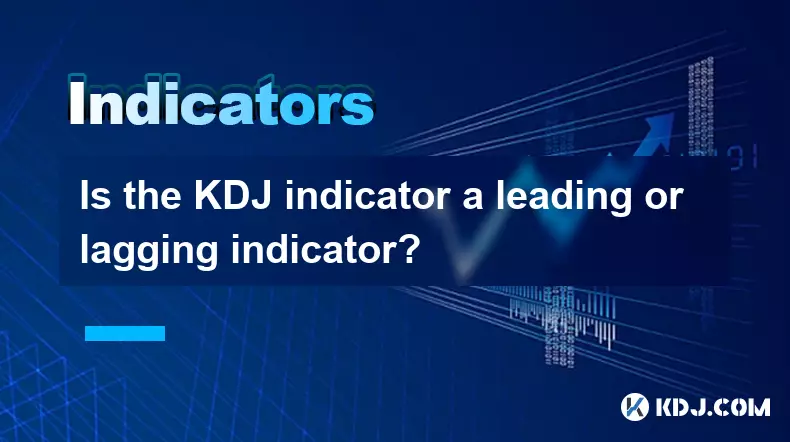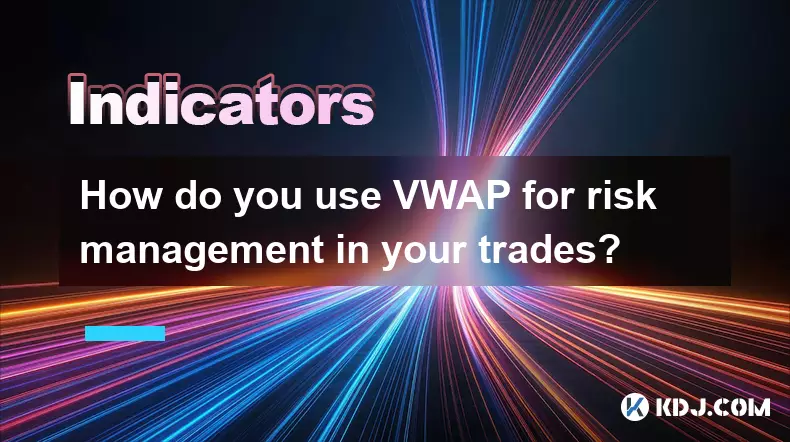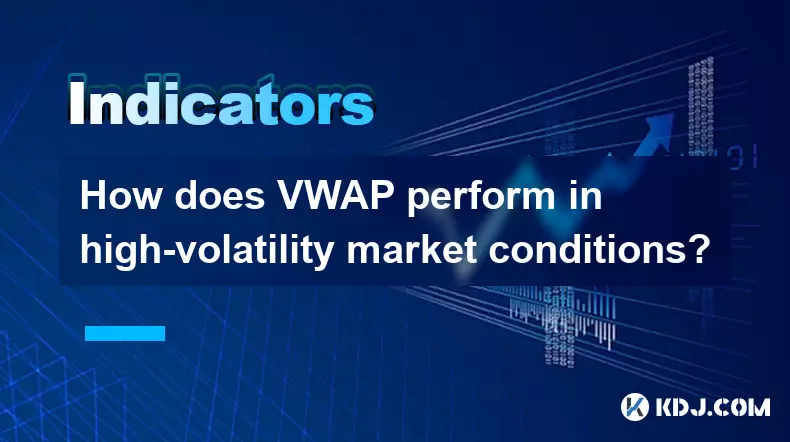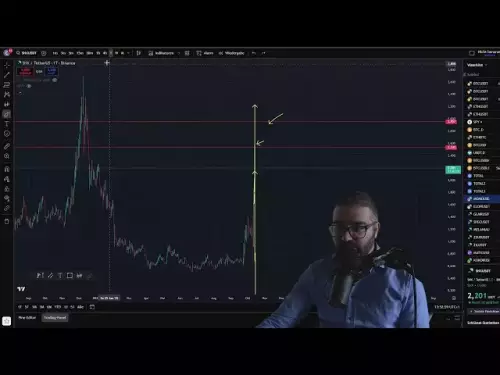-
 bitcoin
bitcoin $115692.075601 USD
5.13% -
 ethereum
ethereum $4162.931611 USD
11.68% -
 bnb
bnb $1310.063287 USD
17.56% -
 tether
tether $1.000983 USD
0.00% -
 xrp
xrp $2.534505 USD
8.16% -
 solana
solana $198.235737 USD
13.49% -
 usd-coin
usd-coin $1.000236 USD
0.02% -
 dogecoin
dogecoin $0.207352 USD
12.89% -
 tron
tron $0.323043 USD
3.62% -
 cardano
cardano $0.701559 USD
11.88% -
 hyperliquid
hyperliquid $39.924597 USD
8.30% -
 chainlink
chainlink $18.934457 USD
11.56% -
 ethena-usde
ethena-usde $1.000552 USD
0.02% -
 stellar
stellar $0.340575 USD
7.05% -
 bitcoin-cash
bitcoin-cash $545.011757 USD
8.86%
Is the KDJ indicator a leading or lagging indicator?
The KDJ indicator serves as both a leading and lagging tool in crypto trading, offering early reversal signals in ranging markets while sometimes lagging during strong trends or volatile news events.
Oct 12, 2025 at 11:37 am

KDJ Indicator: Understanding Its Role in Crypto Trading
The KDJ indicator, also known as the Stochastic Oscillator with a J-line adjustment, is widely used in technical analysis across financial markets, including the cryptocurrency sector. It combines elements of momentum and price action to signal potential turning points in asset prices. Traders often debate whether this tool functions better as a leading or lagging indicator, especially when applied to volatile digital assets.
What Makes the KDJ a Leading Indicator?
1. The KDJ indicator reacts quickly to changes in price momentum by measuring the current closing price relative to the high-low range over a specific period, typically 9 days. This responsiveness allows it to generate early signals before a trend fully establishes itself.
- By incorporating the J-line, which represents three times the K-value minus two times the D-value, the indicator amplifies short-term fluctuations. These exaggerated movements can foreshadow reversals or exhaustion in market sentiment, particularly useful in fast-moving crypto markets.
- When the K and D lines cross below oversold levels (below 20) and begin rising, or above overbought levels (above 80) and start falling, traders interpret these crossovers as potential entry or exit points ahead of actual price direction shifts.
- In ranging or sideways markets common in certain altcoin trading pairs, the KDJ frequently identifies reversal zones earlier than moving averages or MACD, making it function effectively as a leading tool for timing entries and exits.
When Does the KDJ Act as a Lagging Indicator?
1. Despite its sensitivity, the KDJ relies on historical price data within a defined lookback window. Because it calculates values based on past highs, lows, and closes, it inherently follows price movements rather than predicting them outright.
- During strong trending phases in major cryptocurrencies like Bitcoin or Ethereum, the KDJ may remain in overbought or oversold territory for extended periods. Signals generated during such trends often result in premature trades that go against the prevailing momentum, reflecting its delayed nature.
- Whipsaws—false signals caused by sudden volatility—are common in low-liquidity altcoins. The KDJ might flash a bullish crossover just before a sharp drop, indicating that the signal came too late to be reliable, thus behaving like a lagging metric under erratic conditions.
- Confirmation from other tools such as volume profiles or on-chain metrics is usually required to validate KDJ signals, suggesting that alone, it does not consistently forecast future moves but instead reflects recent market dynamics.
Practical Applications in the Cryptocurrency Market
1. Day traders on platforms like Binance or Bybit use the KDJ in conjunction with candlestick patterns to spot short-term reversals in BTC/USDT or ETH/USDT pairs. A bullish K-D crossover near support, aligned with a hammer candle, increases confidence in a bounce.
- On longer timeframes, swing traders monitor divergences between price and the KDJ line. For example, if Bitcoin makes a higher high while the KDJ registers a lower high, this bearish divergence could warn of weakening upward momentum before an actual pullback occurs.
- Some algorithmic trading bots integrate KDJ thresholds into their logic, automatically placing buy orders when the J-line drops below 0 and sell orders when it surges past 100, capitalizing on extreme readings common in crypto’s amplified cycles.
- In stablecoins or less volatile tokens, where price ranges are tighter, the KDJ tends to produce more accurate signals due to reduced noise, enhancing its utility as a predictive instrument.
- Traders who combine KDJ with RSI and volume-weighted average price (VWAP) report improved accuracy in identifying breakout failures and fakeouts in meme coins prone to pump-and-dump schemes.
Frequently Asked Questions
How is the KDJ different from the standard Stochastic Oscillator?The primary distinction lies in the inclusion of the J-line, which adds an extra layer of sensitivity by emphasizing the difference between the %K and %D lines. While the traditional Stochastic only uses K and D, the J-line in KDJ exaggerates momentum swings, offering more pronounced signals suitable for speculative markets like crypto.
Can the KDJ be used effectively on 5-minute crypto charts?Yes, but with caution. High-frequency data increases the number of signals, yet also raises the risk of false triggers due to market noise. Successful usage requires filtering signals through additional confirmation methods such as order book depth or time-based session filters.
Does the KDJ work well during news-driven price spikes?Not reliably. Sudden macroeconomic announcements or exchange outages can cause abrupt price jumps that distort the KDJ calculation. Since it depends on fixed-period highs and lows, the indicator may show misleading overbought conditions even as prices continue climbing.
Disclaimer:info@kdj.com
The information provided is not trading advice. kdj.com does not assume any responsibility for any investments made based on the information provided in this article. Cryptocurrencies are highly volatile and it is highly recommended that you invest with caution after thorough research!
If you believe that the content used on this website infringes your copyright, please contact us immediately (info@kdj.com) and we will delete it promptly.
- XRP Price Prediction: Weekend Rollercoaster or Rally?
- 2025-10-12 08:45:16
- Bittensor (TAO): Super Bullish Signals Point to Potential 2x Rally
- 2025-10-11 10:25:12
- Silver Price Correction: Navigating the Dip & Identifying Key SEO Keywords
- 2025-10-11 10:25:12
- Decoding Crypto Trends: Bittensor's Bull Run, Cardano's Dip, and LivLive's Presale Buzz in 'Uptober 2025'
- 2025-10-12 08:45:16
- MoonBull: The Crypto Meme Coin Promising 1000x Gains?
- 2025-10-11 10:30:01
- Crypto Payroll Revolution: Stablecoins, Altcoins, and the Future of Salary Payments
- 2025-10-11 10:30:01
Related knowledge

What's the main difference between VWAP and TWAP?
Oct 12,2025 at 11:54am
Understanding VWAP and Its Role in Crypto Trading1. Volume Weighted Average Price (VWAP) is a trading benchmark that calculates the average price of a...

How do you identify exhaustion moves using VWAP and its bands?
Oct 12,2025 at 08:00am
Understanding the Role of Decentralized Exchanges in Crypto Trading1. Decentralized exchanges (DEXs) operate without a central authority, allowing use...

What are the main advantages of using VWAP over EMA?
Oct 11,2025 at 02:18am
Main Advantages of Using VWAP Over EMA1. Volume-Weighted Average Price (VWAP) incorporates trading volume into its calculation, offering a more accura...

How do you use VWAP on different chart types like Heikin Ashi?
Oct 11,2025 at 05:01pm
Understanding VWAP in the Context of Heikin Ashi Charts1. The Volume Weighted Average Price (VWAP) is a powerful analytical tool commonly used by trad...

How do you use VWAP for risk management in your trades?
Oct 11,2025 at 02:54am
Understanding VWAP as a Dynamic Benchmark1. The Volume Weighted Average Price (VWAP) serves as a crucial reference point in intraday trading by reflec...

How does VWAP perform in high-volatility market conditions?
Oct 10,2025 at 08:00pm
Understanding VWAP in Turbulent Market Phases1. Volume-Weighted Average Price (VWAP) serves as a benchmark for institutional traders aiming to assess ...

What's the main difference between VWAP and TWAP?
Oct 12,2025 at 11:54am
Understanding VWAP and Its Role in Crypto Trading1. Volume Weighted Average Price (VWAP) is a trading benchmark that calculates the average price of a...

How do you identify exhaustion moves using VWAP and its bands?
Oct 12,2025 at 08:00am
Understanding the Role of Decentralized Exchanges in Crypto Trading1. Decentralized exchanges (DEXs) operate without a central authority, allowing use...

What are the main advantages of using VWAP over EMA?
Oct 11,2025 at 02:18am
Main Advantages of Using VWAP Over EMA1. Volume-Weighted Average Price (VWAP) incorporates trading volume into its calculation, offering a more accura...

How do you use VWAP on different chart types like Heikin Ashi?
Oct 11,2025 at 05:01pm
Understanding VWAP in the Context of Heikin Ashi Charts1. The Volume Weighted Average Price (VWAP) is a powerful analytical tool commonly used by trad...

How do you use VWAP for risk management in your trades?
Oct 11,2025 at 02:54am
Understanding VWAP as a Dynamic Benchmark1. The Volume Weighted Average Price (VWAP) serves as a crucial reference point in intraday trading by reflec...

How does VWAP perform in high-volatility market conditions?
Oct 10,2025 at 08:00pm
Understanding VWAP in Turbulent Market Phases1. Volume-Weighted Average Price (VWAP) serves as a benchmark for institutional traders aiming to assess ...
See all articles










































































